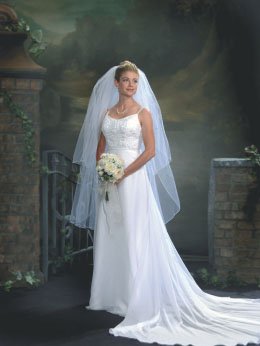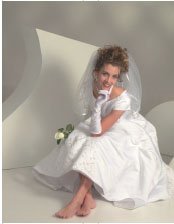articles/Portraiture/cameraroom-page2
Back into the Camera Room by Dave Newman - part 2 of 1 2
by Dave Newman Published 01/12/2002

The Perfect Camera Room?
It seems that the greatest of all challenges to anyone wishing to create the so-called perfect camera room is visualizing just what will be expected of the camera room. Although it seems ridiculous to accommodate all desires, we must at least attempt to establish a camera room which can accommodate most requests. The real trick is creating a camera room which can be quickly converted into a variety of lighting and posing considerations. This is the very quest of this summary.
The 90% Focus Rule
Our attention, when it comes to performance within our camera room, should be 90% with the customer, and 10% fussing with our equipment. Of course, my "do all" requirements were a bit much, but my effort in that direction work out with very suitable results. The main task of this studio is to be multifunctional as relates to "rapid changeovers," all with the PE factor in mind. If we booked merely one session per day I would have no argument with anyone, but our studio is a bustle with a variety of requests linked to the fact that our market area suffers from some form of financial myopia (Utah being the third poorest per capita income in the nation) thus we need to minimize, economize and efficiently use our camera room space.

The Fill Light
For ultimate simplicity I use a fixed fill light which gives me freedom and the speed and efficiency I require. This light moves into the correct location with fingertip ease, producing the required density for negative/digital with a non-evident, non-specular degree of illumination. For optimum quality prints, one needs to bring the base illumination up into the acceptable zone. A simple electronic flash bounce system provides adequate illumination for all my studio needs. Seldom do we adjust the basic subject to fill illumination level. Set it , leave it! In the particular camera room presented here, however, we move or slide the entire track mounted fill unit into optimum position for each side of the duel-directional camera room. Vinyl corrugated roofing material lines the curved bounce surface of this sliding unit. If you have the space and can use two directions, use a highkey and lowkey sides. Only one flash head is required for the "high or mid-key" bounce fill direction of the camera room, while two are necessary for the low key direction. I call this fixed fill-light my "pockets and sockets" illuminator, since it simply fills with non-evident light.
The Keylight
My artistic camera room "paint brush" now becomes my keylight. Your choice may be different but I use a custom-built, modified 27" barn-doored soft box. Since this light must provide the facial contouring and artistic illumination for the subject, it must be very flexible and movable. This keylight is mounted onto a smooth rolling stand with easy height adjustment features. Feathering and adjustment of the power to comply with your personal ratio requirements becomes art mixed with science. Most of our work revolves around a 1:4 or 1:5 ratio (fill-to-key-to-subject) when using some diffusion (which lower ratios considerably). Barn doors control this powerful light, which could otherwise destroy delicate background cucalorus patterns or the use of coloured background gels. Having established the ratio by utilization of a fixed fill light, and working with the minimum of extraneous studio light, one can "see" to meticulously chisel out the details of the facial plains by means of the keylight's modeling lamp. Now by the flattering magic of the keylight's illumination, we perform the task for which we are monetarily rewarded.
Separation Lights.
Generally all light "behind" the subject, I consider my separation lights, i.e., hairlight and background light (place onto a mini stand and used with very low power at a height of about 3 feet). Using a "fixed," ceiling mounted hairlight for dark hair separation is a boon to the speed function of the camera room. Only the power is altered to facilitate simplicity in camera room lighting techniques. A long, narrow softbox is used to more adequately add separation with groups as well as individuals. I find it necessary to use a remote controlled lighting unit with this hairlight as adjustments are very often called for. Note: if you do desire some movement in the direction of this light, I have had great success in one of my studios which uses an inexpensive remote controlled video pan head unit.
More meat and potatoes
Hard surface, not plush, commercial type carpeting is essential throughout,since rolling light stands and costly 'drop-down" painted floor length backgrounds require firmness for function. The large area is very capable of handling large group requests prevalent in our market area, but would appear to be somewhat large for most portrait camera rooms in other cities. The full length highkey background is painted, reversed vinyl flooring. This end of the camera room area is used universally for mid and high key work. This area creates a unique and usable seamless background for a myriad of posing and grouping considerations from brides to commercial setups. My choice for optics is the Fuji S-2 or the Mamiya RZ's Sekor 100-200 zoom with G-3 vignetter, which has be artfully designed for camera room requirements. Also, rolling, mono pod type, camera stands, not tripods, are designed for speedy and efficient camera room use. Singles and businessmen are photographed digitally with a Fuji Pro S-2. Using Photoshop 7.0, we then rework and print on one of our two Fujix PG 3000s.
A Final Word Yes, you say, but the "do-all/be-all" studio's existence is on the wane, isn't it? Perhaps, and if you're highly specialized in your expertise you may wish to give this article to your best friend, but if you're willing and able to make the most of your many customer requests and their many dollars, consider streamlining your camera room and then "show me your Cadillac".
Please Note:
There is more than one page for this Article.
You are currently on page 2 Contact Dave Newman
1st Published 01/12/2002
last update 09/12/2022 14:52:07
More Portraiture Articles
There are 1 days to get ready for The Society of Photographers Convention and Trade Show at The Novotel London West, Hammersmith ...
which starts on Wednesday 14th January 2026





